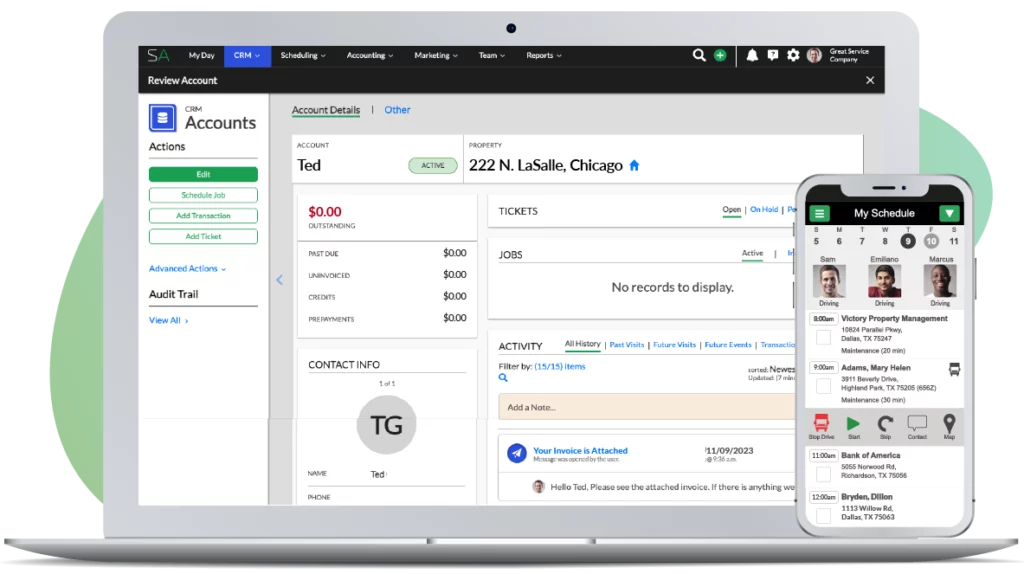Jonathan shares a fool proof plan to prep your seasonal business to have enough money during winter months.
As you’ve probably heard me say in the past, I’m not a big fan of contracts in the residential business. Commercial’s different. I’m talking specifically about residential. One of the big arguments for contracts is that you receive your revenue over a twelve month period because the argument is during the down time, during the off season, during the slower months, there isn’t as much money coming in and those contracts provide for great off season revenue to keep things running and smooth out cash flow. My basic argument is that it doesn’t make sense to put yourself under a contract with a client so that they can be your savings account and make sure you don’t overspend in the months that bring in a lot of revenue and therefore not have enough money in the slow season.
That’s your job, my job as a business owner, to self-regulate ourselves and make sure that we have set aside enough money to get us through the slow time.
I want to give an idea on how to solve this problem without requiring all of your clients to be under a contract. There’s probably things you could refute in my example. There’s probably things I haven’t thought through. I tried to put this together pretty quick to communicate a concept. The idea comes from a number of ServiceAutopilot Academy members that asked my opinion of a book called Profit First. The premise of that book is that you set aside some percentage of your revenue into a profit account, a separate bank account, and that forces you to save profit and then with what’s leftover, you actually live or run your company off that money. It’s a forced savings plan. It’s a forced plan to create profit in your business and not overspend. That idea, that concept, gave me an idea that could apply to many individuals to solve this contract revenue problem and that’s what I want to show you really quick.
Imagine that you have all of your revenue under contract and it generates $40,000 per month. That means you’re a $480,000 per year company. For simplicity, imagine that you have eliminated all contracts and you’re going to get paid as you perform the work. I realize you can make arguments that the client will either spend more or less depending on whether or not they’re under a contract but let’s assume they spend the exact same amount of money and weather doesn’t move against you and you can make the exact same amount of money, which I believe you can. What you would see with your revenue is, let’s call this January, February and even into March in my fictitious example, revenue is down as compared to the contract months. Then it’s up. It’s up 11% for seven months of the year and then it’s down again in November and it’s down again in December.
The idea is that you need some of the money from the seven months set aside so that you can – the seven months that outperformed what you would have received under contract. You need some of that money set aside so that when November, December, January, and February arrive, you have the cash left over to deal with it. To deal with those months. Swiping the idea from the Profit First book that doesn’t talk about this but uses the example of setting aside profit. What you could do is you could create a checking account and take a percentage of that money every month during your months that yield a lot of additional revenue over what they would have yielded if the revenue was coming through contract revenue and I’ll better explain that in a moment. You can move some percentage of money to essentially a savings account.
The reason why I think this is an issue for many companies is because a lot of companies look at their bank accounts and they determine how much money they have left over to spend. They look at the account, “Oh, I’ve got fifty grand in the account. We can afford to do this.” “Oh, I’ve got ten thousand and payroll is coming. Oh, I can’t afford to do anything right now.” A lot of decisions are made that way which isn’t how it should work but that’s the reality of it and that’s why when you’re not self-regulating or, in my example here, potentially moving some money to a separate account, you think you have more money than you do and then when you get to your lean months, you’re in trouble.
The basic idea is that your money, as you’re depositing checks or charging credit cards, is going into your checking account. You’re living out of that account. Then during the months of the year where you actually bill more revenue than you would’ve had all of your revenue been coming through a contract, you would take a percentage of your money out of your checking account every month and move it to your savings account. In my example, we have seven months and this isn’t that complicated. You can figure it out in advance. My example, seven months of the year, we’re generating $53,000 a month instead of forty because our revenue isn’t equalized through contract installment payments. In other words, we’re bringing in roughly 25% more revenue from April on, April through October I believe in my example here, than we would had the revenue been under contract.
The simple concept would be at the end of each month, you take 25% of the revenue and you move it to a savings account that can’t be touched or can only be touched for an emergency. That way, when you arrive in November, for the last seven months you’ve been taking money out of your account to build your off season fund. This essentially forces you to save the money so you don’t get yourself in trouble and during the seven months of the year when you’re making a lot more money than you would’ve had everything been under contract, you are very clear, you’re crystal clear in fact, about how much you really have to work with because that’s all that remains in your checking account.
If 25% sounds really scary, you can test this concept by just simply doing something like 10%. You can start next year just setting aside just 10% of your revenue. Again, you have to run your numbers and figure out how much additional revenue you actually would bring in so you have to say as a company, we’re going to generate this much money for the year. Then you have to do a little bit of math and figure out how much you need to set aside but there’s some amount that you could pick that’s super conservative. Like in my example, 10% is super conservative. That’s less than half of the actual additional revenue you’re earning. You’re earning 25% more in my example per month than you would’ve been had you had your revenue under contract. If 25% sounds too aggressive, maybe you just make up a number, a small number to start with, and you start setting that aside every month in those months that, as I said, generate a lot of additional revenue.
It may or may not be an idea that works for you but I’ve heard this argument so many times and I wanted to just throw this concept out there. It’s something to think about. See if it would work for you. It’s a way to force yourself to save the money to make sure you don’t get yourself in any trouble. If you get to the end of the year and you make it through all of lean months and you don’t have to touch your savings account, you’ve just created a nice big profit account for you of additional money. You just made for yourself money that you could then take and reinvest in the business to grow it even bigger. There’s a lot of pluses to this concept.




2 Replies to “How To Ensure You Have Enough Money During Winter Season”
One way to build up your winter revenue is to set it asside in a side account while the money is coming in. If you are living off of $5,000 a month income but have several $20-30K months in the summer. Be sure to put that “extra” in that account.
We teach business owners how to do this most effectively by becoming their own banker using The Infinite Banking Concept.
Secondly besides saving your cash for the winter months, you can also use this fund to purchase equipment that will give you flexibility of payments and more control over your cash flow.
Great Article! This is a great challenge for those of us that can’t always depend on firewood or snow removal during the winter months.